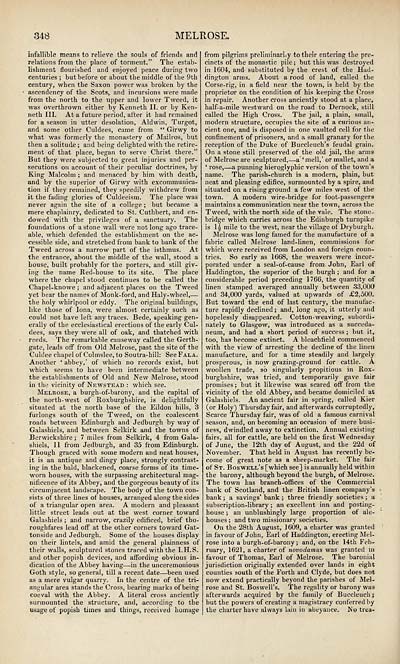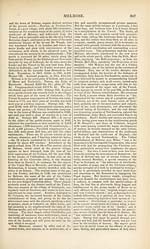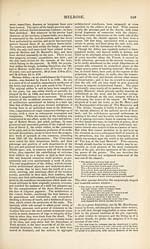Topographical, statistical, and historical gazetteer of Scotland > Volume 2
(364) Page 348 - MEL
Download files
Complete book:
Individual page:
Thumbnail gallery: Grid view | List view

348
MELROSE.
infallible means to relieve the souls of friends and
relations from the place of torment." The estab-
lishment flourished and enjoyed peace during two
centuries ; but before or about the middle of the 9th
century, when the Saxon power was broken by the
ascendency of the Scots, and incursions were made
from the north to the upper and lower Tweed, it
was overthrown either by Kenneth II. or by Ken-
neth III. At a future period, after it had remained
for a season in utter desolation, Aldwin, Turgot,
and some other Culdees, came from " Girwy to
what was formerly the monastery of Mailros, but
then a solitude ; and being delighted with the retire-
ment of that place, began to serve Christ there."
But they were subjected to great injuries and per-
secutions on account of their peculiar doctrines, by
King Malcolm ; and menaced by him with death,
and by the superior of Girwy with excommunica-
tion if they remained, they speedily withdrew from
it the fading glories of Culdeeism. The place was
never again the site of a college ; but became a
mere chaplainry, dedicated to St. Cuthbert, and en-
dowed with the privileges of a sanctuary. The
foundations of a stone wall were not long ago trace-
able, which defended the establishment on the ac-
cessible side, and stretched from bank to bank of the
Tweed across a narrow part of the isthmus. At
the entrance, about the middle of the wall, stood a
house, built probably for the porters, and still giv-
ing the name Red-house to its site. The place
where the chapel stood continues to be called the
Chapel-knowe ; and adjacent places on the Tweed
yet bear the names of Monk-ford, and Haly- wheel, —
the holy whirlpool or eddy. The original buildings,
like those of Iona, were almost certainly such as
could not have left any traces. Bede, speaking gen-
erally of the ecclesiastical erections of the early Cul-
dees, says they were all of oak, and thatched with
reeds. The remarkable causeway called the Gerth-
gate, leads off from Old Melrose, past the site of the
Culdee chapel of Colmslee, to Soutra-hill: See Fala.
Another ' abbey,' of which no records exist, but
which seems to have been intermediate between
the establishments of Old and New Melrose, stood
in the vicinity of Newstead : which see.
Melrose, a burgh-of-barony, and the capital of
the north-west of Roxburghshire, is delightfully
situated at the north base of the Eildon hills, 3
furlongs south of the Tweed, on the coalescent
roads between Edinburgh and Jedburgh by way of
Galashiels, and between Selkirk and the towns of
Berwickshire ; 7 miles from Selkirk, 4 from Gala-
shiels, 11 from Jedburgh, and 35 from Edinburgh.
Though graced with some modern and neat houses,
it is an antique and dingy place, strongly contrast-
ing in the bald, blackened, coarse forms of its time-
worn houses, with the surpassing architectural mag-
nificence of its Abbey, and the gorgeous beauty of its
circumjacent landscape. The body of the town con-
sists of three lines of houses, arranged along the sides
of a triangular open area. A modern and pleasant
little street leads out at the west corner toward
Galashiels ; and narrow, crazily edificed, brief tho-
roughfares lead off at the other corners toward Gat-
tonside and Jedburgh. Some of the houses display
on their lintels, and amid the general plainness of
their walls, sculptured stones traced with the I.H.S.
and other popish devices, and affording obvious in-
dication of the Abbey having — in the unceremonious
Goth style, so general, till a recent date — been used
as a mere vulgar quarry. In the centre of the tri-
angular area stands the Cross, bearing marks of being
coeval with the Abbey. A literal cross anciently
surmounted the structure, and, according to the
usage of popish times and things, received homage
from pilgrims preliminarily to their entering the pre-
cincts of the monastic pile; but this was destroyed
in 1604, and substituted by the crest of the Had-
dington arms. About a rood of land, called the
Corse-rig, in a field near the town, is held by the
proprietor on the condition of his keeping the Cross
in repair. Another cross anciently stood at a place,
half-a-mile westward on the road to Dernock, still
called the High Cross. The jail, a plain, small,
modern structure, occupies the site of a curious an-
cient one, and is disposed in one vaulted cell for the
confinement of prisoners, and a small granary for the
reception of the Duke of Buccleuch's feudal grain.
On a stone still preserved of the old jail, the arms
of Melrose are sculptured, — a ' mell,' or mallet, and a
' rose, — a punning hieroglyphic version of the town's
name. The parish-church is a modern, plain, but
neat and pleasing edifice, surmounted by a spire, and
situated on a rising ground a few mile9 west of the
town. A modern wire-bridge for foot-passengers
maintains a communication near the town, across the
Tweed, with the north side of the vale. The stone-
bridge which carries across the Edinburgh turnpike
is I5 mile to the west, near the village of Dryburgh.
Melrose was long famed for the manufacture of a
fabric called Melrose land-linen, commissions for
which were received from London and foreign coun-
tries. So early as 1668, the weavers were incor-
porated under a seal-of-cause from John, Earl of
Haddington, the superior of the burgh ; and for a
considerable period preceding 1766, the quantity of
linen stamped averaged annually between 33,000
and 34,000 yards, valued at upwards of £2,500.
But toward the end of last century, the manufac
ture rapidly declined ; and, long ago, it utterly and
hopelessly disappeared. Cotton-weaving, subordi-
nately to Glasgow, was introduced as a sueceda-
neum, and had a short period of success ; but it,
too, has become extinct. A bleachfield commenced
with the view of arresting the decline of the linen
manufacture, and for a time steadily and largely
prosperous, is now grazing-ground for cattle. A
woollen trade, so singularly propitious in Rox-
burghshire, was tried, and temporarily gave fair
promises ; but it likewise was scared off from the
vicinity of the old Abbey, and became domiciled at
Galashiels. An ancient fair in spring, called Kier
(or Holy) Thursday fair, and afterwards corruptedly,
Scarce Thursday fair, was of old a famous carnival
season, and, on becoming an occasion of mere busi-
ness, dwindled away to extinction. Annual existing
fairs, all for cattle, are held on the first Wednesday
of June, the 12th day of August, and the 22d of
November. That held in August has recently be-
come of great note as a sheep-market. The fair
of St. Boswell's [which see] is annually held within
the barony, although beyond the burgh, of Melrose.
The town has branch-offices of the Commercial
bank of Scotland, and the British linen company's
bank ; a savings' bank ; three friendly societies ; a
subscription-library ; an excellent inn and posting-
house ; an unblushingly large proportion of ale-
houses ; and two missionary societies.
On the 28th August, 1609, a charter was granted
in favour of John, Earl of Haddington, erecting Mel-
rose into a burgh-of-barony ; and, on the 14th Feb-
ruary, 1621, a charter of novodamus was granted in
favour of Thomas, Earl of Melrose. The baronial
jurisdiction originally extended over lands in eight
counties south of the Forth and Clyde, but does not
now extend practically beyond the parishes of Mel-
rose and St. Boswell's. The regality or barony was
afterwards acquired by the family of Buccleuch;
but the powers of creating a magistracy conferred by
the charter have always lain in abeyance. No trea-
MELROSE.
infallible means to relieve the souls of friends and
relations from the place of torment." The estab-
lishment flourished and enjoyed peace during two
centuries ; but before or about the middle of the 9th
century, when the Saxon power was broken by the
ascendency of the Scots, and incursions were made
from the north to the upper and lower Tweed, it
was overthrown either by Kenneth II. or by Ken-
neth III. At a future period, after it had remained
for a season in utter desolation, Aldwin, Turgot,
and some other Culdees, came from " Girwy to
what was formerly the monastery of Mailros, but
then a solitude ; and being delighted with the retire-
ment of that place, began to serve Christ there."
But they were subjected to great injuries and per-
secutions on account of their peculiar doctrines, by
King Malcolm ; and menaced by him with death,
and by the superior of Girwy with excommunica-
tion if they remained, they speedily withdrew from
it the fading glories of Culdeeism. The place was
never again the site of a college ; but became a
mere chaplainry, dedicated to St. Cuthbert, and en-
dowed with the privileges of a sanctuary. The
foundations of a stone wall were not long ago trace-
able, which defended the establishment on the ac-
cessible side, and stretched from bank to bank of the
Tweed across a narrow part of the isthmus. At
the entrance, about the middle of the wall, stood a
house, built probably for the porters, and still giv-
ing the name Red-house to its site. The place
where the chapel stood continues to be called the
Chapel-knowe ; and adjacent places on the Tweed
yet bear the names of Monk-ford, and Haly- wheel, —
the holy whirlpool or eddy. The original buildings,
like those of Iona, were almost certainly such as
could not have left any traces. Bede, speaking gen-
erally of the ecclesiastical erections of the early Cul-
dees, says they were all of oak, and thatched with
reeds. The remarkable causeway called the Gerth-
gate, leads off from Old Melrose, past the site of the
Culdee chapel of Colmslee, to Soutra-hill: See Fala.
Another ' abbey,' of which no records exist, but
which seems to have been intermediate between
the establishments of Old and New Melrose, stood
in the vicinity of Newstead : which see.
Melrose, a burgh-of-barony, and the capital of
the north-west of Roxburghshire, is delightfully
situated at the north base of the Eildon hills, 3
furlongs south of the Tweed, on the coalescent
roads between Edinburgh and Jedburgh by way of
Galashiels, and between Selkirk and the towns of
Berwickshire ; 7 miles from Selkirk, 4 from Gala-
shiels, 11 from Jedburgh, and 35 from Edinburgh.
Though graced with some modern and neat houses,
it is an antique and dingy place, strongly contrast-
ing in the bald, blackened, coarse forms of its time-
worn houses, with the surpassing architectural mag-
nificence of its Abbey, and the gorgeous beauty of its
circumjacent landscape. The body of the town con-
sists of three lines of houses, arranged along the sides
of a triangular open area. A modern and pleasant
little street leads out at the west corner toward
Galashiels ; and narrow, crazily edificed, brief tho-
roughfares lead off at the other corners toward Gat-
tonside and Jedburgh. Some of the houses display
on their lintels, and amid the general plainness of
their walls, sculptured stones traced with the I.H.S.
and other popish devices, and affording obvious in-
dication of the Abbey having — in the unceremonious
Goth style, so general, till a recent date — been used
as a mere vulgar quarry. In the centre of the tri-
angular area stands the Cross, bearing marks of being
coeval with the Abbey. A literal cross anciently
surmounted the structure, and, according to the
usage of popish times and things, received homage
from pilgrims preliminarily to their entering the pre-
cincts of the monastic pile; but this was destroyed
in 1604, and substituted by the crest of the Had-
dington arms. About a rood of land, called the
Corse-rig, in a field near the town, is held by the
proprietor on the condition of his keeping the Cross
in repair. Another cross anciently stood at a place,
half-a-mile westward on the road to Dernock, still
called the High Cross. The jail, a plain, small,
modern structure, occupies the site of a curious an-
cient one, and is disposed in one vaulted cell for the
confinement of prisoners, and a small granary for the
reception of the Duke of Buccleuch's feudal grain.
On a stone still preserved of the old jail, the arms
of Melrose are sculptured, — a ' mell,' or mallet, and a
' rose, — a punning hieroglyphic version of the town's
name. The parish-church is a modern, plain, but
neat and pleasing edifice, surmounted by a spire, and
situated on a rising ground a few mile9 west of the
town. A modern wire-bridge for foot-passengers
maintains a communication near the town, across the
Tweed, with the north side of the vale. The stone-
bridge which carries across the Edinburgh turnpike
is I5 mile to the west, near the village of Dryburgh.
Melrose was long famed for the manufacture of a
fabric called Melrose land-linen, commissions for
which were received from London and foreign coun-
tries. So early as 1668, the weavers were incor-
porated under a seal-of-cause from John, Earl of
Haddington, the superior of the burgh ; and for a
considerable period preceding 1766, the quantity of
linen stamped averaged annually between 33,000
and 34,000 yards, valued at upwards of £2,500.
But toward the end of last century, the manufac
ture rapidly declined ; and, long ago, it utterly and
hopelessly disappeared. Cotton-weaving, subordi-
nately to Glasgow, was introduced as a sueceda-
neum, and had a short period of success ; but it,
too, has become extinct. A bleachfield commenced
with the view of arresting the decline of the linen
manufacture, and for a time steadily and largely
prosperous, is now grazing-ground for cattle. A
woollen trade, so singularly propitious in Rox-
burghshire, was tried, and temporarily gave fair
promises ; but it likewise was scared off from the
vicinity of the old Abbey, and became domiciled at
Galashiels. An ancient fair in spring, called Kier
(or Holy) Thursday fair, and afterwards corruptedly,
Scarce Thursday fair, was of old a famous carnival
season, and, on becoming an occasion of mere busi-
ness, dwindled away to extinction. Annual existing
fairs, all for cattle, are held on the first Wednesday
of June, the 12th day of August, and the 22d of
November. That held in August has recently be-
come of great note as a sheep-market. The fair
of St. Boswell's [which see] is annually held within
the barony, although beyond the burgh, of Melrose.
The town has branch-offices of the Commercial
bank of Scotland, and the British linen company's
bank ; a savings' bank ; three friendly societies ; a
subscription-library ; an excellent inn and posting-
house ; an unblushingly large proportion of ale-
houses ; and two missionary societies.
On the 28th August, 1609, a charter was granted
in favour of John, Earl of Haddington, erecting Mel-
rose into a burgh-of-barony ; and, on the 14th Feb-
ruary, 1621, a charter of novodamus was granted in
favour of Thomas, Earl of Melrose. The baronial
jurisdiction originally extended over lands in eight
counties south of the Forth and Clyde, but does not
now extend practically beyond the parishes of Mel-
rose and St. Boswell's. The regality or barony was
afterwards acquired by the family of Buccleuch;
but the powers of creating a magistracy conferred by
the charter have always lain in abeyance. No trea-
Set display mode to: Large image | Transcription
Images and transcriptions on this page, including medium image downloads, may be used under the Creative Commons Attribution 4.0 International Licence unless otherwise stated. ![]()
| Gazetteers of Scotland, 1803-1901 > Topographical, statistical, and historical gazetteer of Scotland > Volume 2 > (364) Page 348 - MEL |
|---|
| Permanent URL | https://digital.nls.uk/97498331 |
|---|
| Description | Volume second. I-Z. |
|---|---|
| Attribution and copyright: |
|

